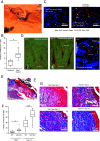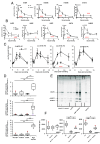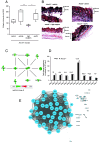12/15-lipoxygenase orchestrates murine wound healing via PPARγ-activating oxylipins acting holistically to dampen inflammation
- PMID: 40906806
- PMCID: PMC12435204
- DOI: 10.1073/pnas.2502640122
12/15-lipoxygenase orchestrates murine wound healing via PPARγ-activating oxylipins acting holistically to dampen inflammation
Abstract
12/15-lipoxygenase (12/15-LOX, Alox15) generates bioactive oxygenated lipids during inflammation, however its homeostatic role(s) in normal healing are unclear. Here, the role of 12/15-LOX in resolving skin wounds was elucidated, focusing on how its lipids act together in physiologically relevant amounts. In mice, wounding caused acute appearance of 12/15-LOX-expressing macrophages and stem cells, coupled to early generation of ~12 monohydroxy-oxylipins and enzymatically oxidized phospholipids (eoxPL). Alox15 deletion increased collagen deposition, stem cell/fibroblast proliferation, IL6/pSTAT3, pSMAD3, and interferon (IFN)-γ levels. Conversely, CD206 expression, F480+ cells, and MMP9 and MMP2 activities were reduced. Alox15-/- skin was deficient in PPARγ/adiponectin activity. Furthermore, while pro-inflammatory genes were upregulated as normal during wounding, many including Il6, Il1b, ccl4, Cd14, Cd274, Clec4d, Clec4e, Csf3, Cxcl2, and miR-21 failed to revert to baseline during healing, indicating disruption of PPARγ's anti-inflammatory brake on NLRP3/inflammasome and TGF-β signaling. Reconstituting Alox15-/- wounds with a physiological mixture of Alox15-derived primary oxylipins generated by healing wounds restored MMP and dampened collagen deposition. The oxylipin mixture activated the PPARγ response element in vitro, while in vivo, its coactivator, Helz2, was significantly upregulated as well as several fatty acid and prostaglandin PPARγ ligands. Additional inflammatory and proliferative gene networks impacted by Alox15-/- included Elf4, Cebpb, and Tcf3. In summary, 12/15-LOX generates abundant monohydroxy oxylipins that act together via PPARγ. The identification of multiple gene alterations reveals several targets for treating nonhealing wounds. Our studies demonstrate that 12/15-LOX oxylipins act in concert, dampening inflammation in vivo, revealing the need to consider lipid signaling holistically.
Keywords: lipid; lipoxygenase; oxylipin; wound.
Conflict of interest statement
Competing interests statement:The authors declare no competing interest.
Figures





References
-
- Heydeck D., et al. , Interleukin-4 and -13 induce upregulation of the murine macrophage 12/15-lipoxygenase activity: Evidence for the involvement of transcription factor STAT6. Blood 92, 2503–2510 (1998). - PubMed
-
- Kuhn H., O’Donnell V. B., Inflammation and immune regulation by 12/15-lipoxygenases. Prog. Lipid Res. 45, 334–356 (2006). - PubMed
MeSH terms
Substances
Grants and funding
LinkOut - more resources
Full Text Sources
Research Materials
Miscellaneous

